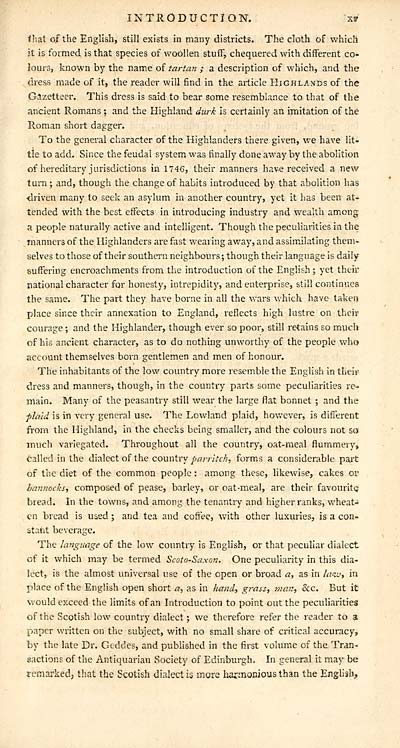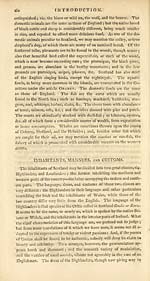Gazetteer of Scotland
(27) Page xv
Download files
Complete book:
Individual page:
Thumbnail gallery: Grid view | List view

INTRODUCTION. xy
that of the English, still exists in many districts. The cloth of whicli
it is formed is that species of woollen stuff, chequered with different co-
lours, known by the name of tartan ; a description of which, and the
dress made of it, the reader will find in the article Highlands of the
Gazetteer. This dress is said to bear some i-esemblance to that of the
ancient Romans ; and the Highland durk is certainly an imitation of the
Roman short dagger.
To the general character of the Highlanders there given, we have lit-
tle to add. Since the feudal system was finally done away by the abolition
of hereditary jurisdictions in 1746, their manners have received a new
turn ; and, though the change of habits introduced by that abolition has
driven many to seek an asylum in another country, yet it has been at-
tended with the best effects in introducing industry and wealth among
a people naturally active and intelligent. Though the peculiarities in the
manners of the Highlanders are fast wearing away, and assimilating them-
selves to those of their southern neighbours; though their language is daily
suffering encroachments from the introduction of the English ; yet their
national character for honesty, intrepidity, and enterprise, still continues
the same. The part they have borne in all the wars which have taken
place since their annexation to England, reflects high lustre on their
courage ; and the Highlander, though ever so poor, still retains so much
of his ancient character, as to do nothing unworthy of the people who
account themselves born gentlemen and men of honour.
The inhabitants of the low country more resemble the English in their
dress and manners, though, in the country parts some peculiarities re-
main. Many of the peasantry still wear the large flat bonnet ; and the
■plaid is in very general use. The Lowland plaid, however, is different
from the Highland, in the checks being smaller, and the colours not so
much variegated. Throughout all the country, oat-meal flummery,
called in the dialect of the country parrltch, forms a considerable part
of the diet of the common people : among these, likewise, cakes or
bannocks, composed of pease, barley, or oat-meal, are their favourite
bread. In the towns, and among the tenantry and higher ranks, wheat-
en bread is used ; and tea and coffee, with other luxuries, is a con-
stant beverage.
The language of the low country is English, or that peculiar dialect
of it which may be termed Scoto-Saxon. One peculiarity in this dia-
lect, is the almost universal use of the open or broad a, as in laiv, in
place of the English open short a, as in ha?id, grass, man, &c. But it
would exceed the limits of an Introduction to point out the peculiarities
of the Scotish low country dialect ; we therefore refer the reader to a
paper written on the subject, with no small share of critical accuracy,
by the late Dr. Geddes, and published in the first volume of the Tran-
sactions of the Antiquarian Society of Edinburgh. In general it may be
remarked, that the Scotish dialect is mere harmonious than the English,
that of the English, still exists in many districts. The cloth of whicli
it is formed is that species of woollen stuff, chequered with different co-
lours, known by the name of tartan ; a description of which, and the
dress made of it, the reader will find in the article Highlands of the
Gazetteer. This dress is said to bear some i-esemblance to that of the
ancient Romans ; and the Highland durk is certainly an imitation of the
Roman short dagger.
To the general character of the Highlanders there given, we have lit-
tle to add. Since the feudal system was finally done away by the abolition
of hereditary jurisdictions in 1746, their manners have received a new
turn ; and, though the change of habits introduced by that abolition has
driven many to seek an asylum in another country, yet it has been at-
tended with the best effects in introducing industry and wealth among
a people naturally active and intelligent. Though the peculiarities in the
manners of the Highlanders are fast wearing away, and assimilating them-
selves to those of their southern neighbours; though their language is daily
suffering encroachments from the introduction of the English ; yet their
national character for honesty, intrepidity, and enterprise, still continues
the same. The part they have borne in all the wars which have taken
place since their annexation to England, reflects high lustre on their
courage ; and the Highlander, though ever so poor, still retains so much
of his ancient character, as to do nothing unworthy of the people who
account themselves born gentlemen and men of honour.
The inhabitants of the low country more resemble the English in their
dress and manners, though, in the country parts some peculiarities re-
main. Many of the peasantry still wear the large flat bonnet ; and the
■plaid is in very general use. The Lowland plaid, however, is different
from the Highland, in the checks being smaller, and the colours not so
much variegated. Throughout all the country, oat-meal flummery,
called in the dialect of the country parrltch, forms a considerable part
of the diet of the common people : among these, likewise, cakes or
bannocks, composed of pease, barley, or oat-meal, are their favourite
bread. In the towns, and among the tenantry and higher ranks, wheat-
en bread is used ; and tea and coffee, with other luxuries, is a con-
stant beverage.
The language of the low country is English, or that peculiar dialect
of it which may be termed Scoto-Saxon. One peculiarity in this dia-
lect, is the almost universal use of the open or broad a, as in laiv, in
place of the English open short a, as in ha?id, grass, man, &c. But it
would exceed the limits of an Introduction to point out the peculiarities
of the Scotish low country dialect ; we therefore refer the reader to a
paper written on the subject, with no small share of critical accuracy,
by the late Dr. Geddes, and published in the first volume of the Tran-
sactions of the Antiquarian Society of Edinburgh. In general it may be
remarked, that the Scotish dialect is mere harmonious than the English,
Set display mode to: Large image | Transcription
Images and transcriptions on this page, including medium image downloads, may be used under the Creative Commons Attribution 4.0 International Licence unless otherwise stated. ![]()
| Gazetteers of Scotland, 1803-1901 > Gazetteer of Scotland > (27) Page xv |
|---|
| Permanent URL | https://digital.nls.uk/97414886 |
|---|

